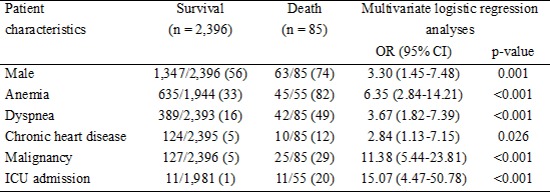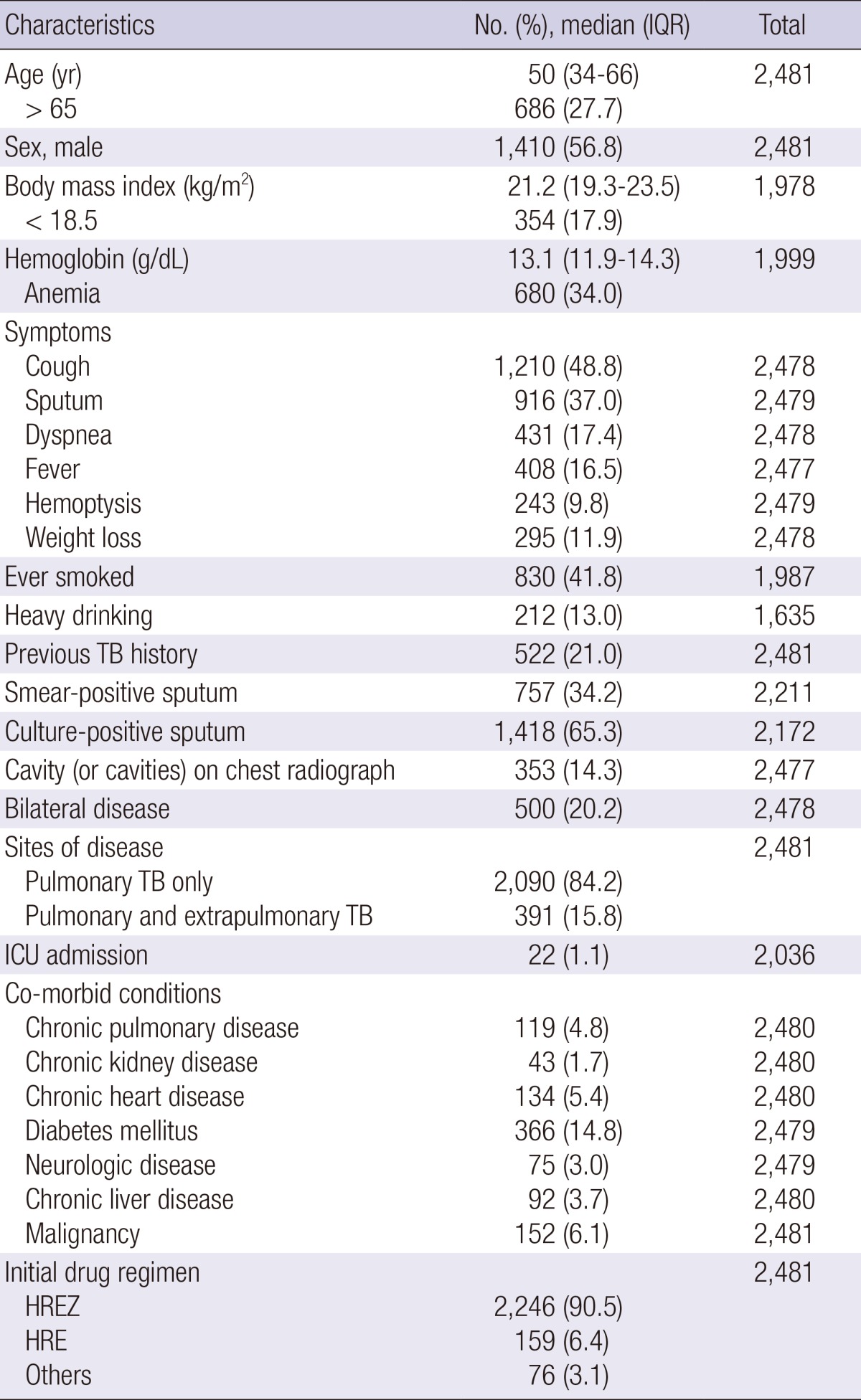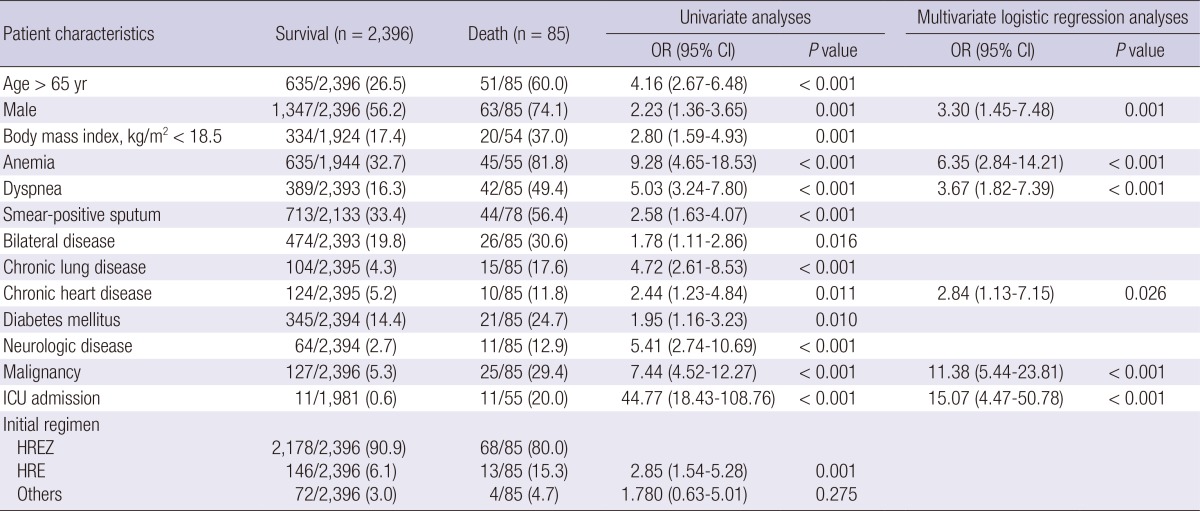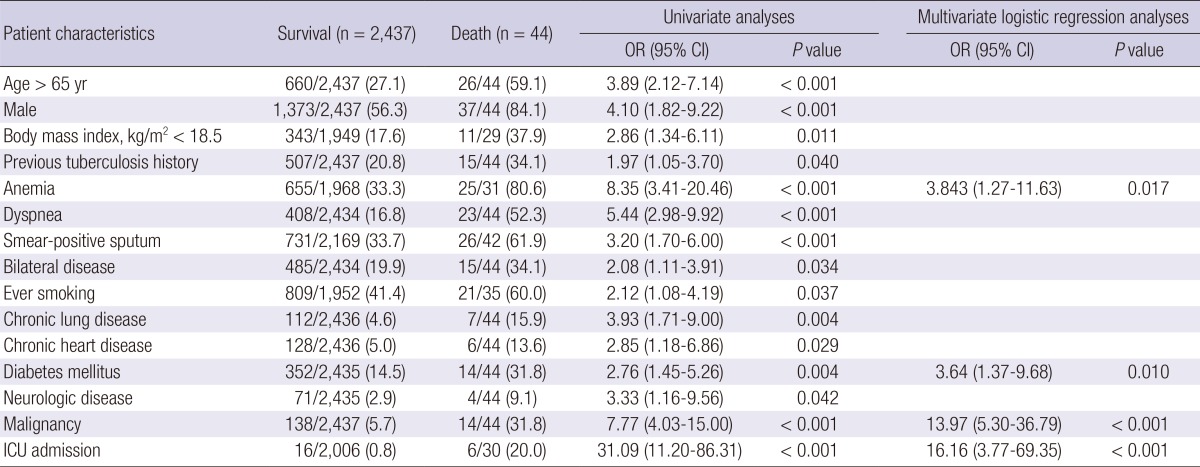Abstract
The data regarding risk factors for death during tuberculosis (TB) treatment are inconsistent, and few studies examined this issue in Korea. The purpose of this study was to evaluate baseline prognostic factors for death during treatment of adult patients with pulmonary TB in Korea. A multicenter retrospective cohort study of 2,481 patients who received TB treatment at eight hospitals from January 2009 to December 2010 was performed. Successful treatment included cure (1,129, 45.5%) and treatment completion (1,204, 48.5%) in 2,333 patients (94.0%). Unsuccessful treatment included death (85, 3.4%) and treatment failure (63, 2.5%) occurred in 148 patients (6.0%). In multivariate analysis, male sex, anemia, dyspnea, chronic heart disease, malignancy, and intensive care unit (ICU) admission were significant risk factors for death during TB treatment. Therefore, male sex, anemia, dyspnea, chronic heart disease, malignancy, and ICU admission could be baseline prognostic factors for death during treatment of adult patients with pulmonary TB in Korea.
Graphical Abstract

Keywords: Tuberculosis, Pulmonary; Therapeutics; Mortality, Korea
INTRODUCTION
The incidence and mortality of tuberculosis (TB) remain high worldwide, with 8.6 million incident cases and 1.3 million deaths in 2012 (1). In Korea, TB is a major health problem with no decrease in notified TB cases during the last decade. It has high mortality rate, which is the highest among the infectious diseases and was 4.9/100,000 persons in 2012 (2, 3, 4, 5, 6). Thus the incidence and mortality rate of TB must be reduced, and knowledge of risk factors for death during TB is critical.
Several studies have evaluated risk factors for death during TB treatment, and many factors related to age, sex, bacteriological status, co-morbid conditions, the immune and nutritional status of host, and substance abuse have been suggested (7, 8, 9, 10, 11, 12, 13, 14, 15, 16, 17, 18, 19, 20, 21). However, the findings are inconsistent due to differences in the enrolled subjects, the burden of TB in the involved countries, human immunodeficiency virus (HIV) infection prevalence, and socioeconomic status (7, 8, 9, 10, 11, 12, 13, 14, 15, 16, 17, 18, 19, 20, 21).
In Korea, which has an intermediate burden of TB and a low incidence of HIV infection (22, 23), few studies with few enrolled patients have examined this issue (11, 21). In an effort to clarify this issue, we herein report the risk factors for death during TB treatment in a large multicenter retrospective cohort in Korea.
MATERIALS AND METHODS
Study population
All adult patients older than 18-yr-of-age who were diagnosed and treated for pulmonary TB, and were notified in the Korean Tuberculosis Surveillance System at eight hospitals (greater than 500 beds) in Korea between January 2009 and December 2010, were enrolled. We retrospectively collected clinical, radiographic, and bacteriological status data of these patients. In co-morbid conditions, chronic pulmonary disease was defined as a non-infectious chronic pulmonary disease such as chronic obstructive pulmonary disease and asthma. Chronic kidney disease was defined as a disease causing a progressive loss in renal function. Chronic heart disease was defined as a disease which needed a long term use of cardiac medications such as coronary artery disease, valvular heart disease, cardiomyopathy, and cardiac arrhythmias. Chronic liver disease was defined as a disease causing progressive destruction and regeneration of liver parenchyma such as chronic viral hepatitis, alcoholic liver disease, and liver cirrhosis. Anemia was defined by World Health Organization guidelines as hemoglobin <13 g/dL (males) or <12 g/dL (female) at baseline (24).
Of the 4,502 patients with TB, we excluded patients who displayed extrapulmonary TB (n=1,005), who had unknown sites of infection (n=21), who had been transferred to another institute before treatment completion (n=444), whose final diagnosis was changed to another disease than TB (n=193), who had interrupted TB treatment for 2 or more consecutive months (n=178), who had unknown treatment outcomes (n=172), and who had positive HIV antibodies (n=8). Finally, 2,481 patients with pulmonary TB were included in this study.
In Korea, a 6-month regimen consisting of a 2-month initial phase of isoniazid, rifampicin, pyrazinamide, and ethambutol, followed by a 4-month continuation phase of isoniazid, rifampicin, and ethambutol has been recommended by the National Tuberculosis Program (25, 26). Alternatively, a 9-month regimen with isoniazid, rifampin, and ethambutol can be administered (25, 26). Therefore, most patients in this study received daily therapy consisting of isoniazid, rifampin, ethambutol, and pyrazinamide. However, the inclusion of pyrazinamide in the initial regimen was made by clinicians based on each patient's clinical situation. TB drugs were self-administered with the support of trained nurses in Public-Private Mix project during treatment (27, 28).
Treatment outcomes
For these analyses, we used the World Health Organization definitions and recommendations regarding cure, treatment completion, treatment failure, and death (26). Death was defined as dying during treatment irrespective of cause.
Statistical analyses
Values are expressed as medians and interquartile range (IQR), or as numbers (percentages) in the text and tables. Categorical comparisons of death versus survival were performed using chi-square tests. To evaluate the risk factors for death during TB treatment, we compared selected clinical variables between the death and survival groups using univariate comparison and subsequent multiple logistic regression. In regression, stepwise and backward selection procedures were used to select variables to be maintained in the final model, with a P value of <0.05 as the criterion for statistical significance. Calculations were performed using SPSS for Windows version 21.0 (SPSS, Armonk, NY, USA).
Ethics statement
Permission was obtained from the institutional review board of Chonnam National University Hospital to review and publish patient records retrospectively (IRB No. CNUH-2014-057). Informed consent was waived due to the retrospective nature of the study.
RESULTS
Patients' characteristics
Table 1 summarizes the baseline characteristics of the 2,481 pulmonary TB patients. The median age was 50.0 yr (IQR 34.0-66.0 yr), and there were 1,417 males (57.1%). Of 1,551 patients who had drug susceptibility tests, isoniazid-resistant TB, which was defined as resistance to isoniazid alone or isoniazid plus streptomycin (29), and multidrug-resistant (MDR) TB, which was defined as resistant to both isoniazid and rifampin (30), were 61 (3.9%) and 67 (4.3%) cases, respectively. Culture confirmed cases that were positive on a sputum culture for Mycobacterium tuberculosis were 1,418 (65.3%) of 2,172 patients who had results of sputum culture.
Table 1.
Baseline characteristics of pulmonary tuberculosis patients

Data are presented as medians (interquartile range, IQR) for age, body mass index, and hemoglobin and as No. (%) for all other factors. TB, tuberculosis; ICU, intensive care unit; HREZ, isoniazid, rifampin, ethambutol, and pyrazinamide; HRE, isoniazid, rifampin, and ethambutol.
Treatment outcomes
Of the enrolled patients, 2,333 (94.0%) had successful treatment, including 1,129 (45.5%) cured patients and 1,204 (48.5%) patients that completed treatment. Unsuccessful treatment occurred in 94 patients, with 85 deaths (3.4%) and 63 treatment failures (2.5%). Of 85 patients who died, TB-related deaths and other causes of deaths were 44 (51.8%) and 41 (48.2%), respectively. All of 63 treatment failure cases had MDR-TB. The median duration between the initiation of TB treatment and death was 41.5 days (IQR 7.0-91.3 days).
Risk factors for death
In risk factors for all cause of death during TB treatment, advanced age (>65 yr), male sex, low body mass index (BMI, <18.5 kg/m2), anemia, dyspnea, positive sputum smear, bilateral disease, chronic pulmonary disease, chronic heart disease, diabetes mellitus, neurologic disease, malignancy, different initial drug regimens, and admission to an intensive care unit (ICU) at the start of treatment were significant in univariate analyses. However, in multivariate analyses, male sex, anemia, dyspnea, chronic heart disease, malignancy, and ICU admission were significant (Table 2).
Table 2.
Risk factors for all-cause death in pulmonary tuberculosis patients during tuberculosis treatment

Data are presented as No. (%). OR, odd ratio; CI, confidence interval; ICU, intensive care unit; HREZ, isoniazid, rifampin, ethambutol, and pyrazinamide; HRE, isoniazid, rifampin, and ethambutol.
In risk factors for TB-related death, advanced age, male sex, low body mass index, previous TB treatment, ever smoking, anemia, dyspnea, positive sputum smear, bilateral disease, chronic pulmonary disease, chronic heart disease, diabetes mellitus, neurologic disease, malignancy, and admission to an ICU at the start of treatment were significant in univariate analyses. However, in multivariate analyses, anemia, diabetes mellitus, malignancy, and ICU admission were independent risk factors for TB-related death during TB treatment (Table 3).
Table 3.
Risk factors for tuberculosis-related death in pulmonary tuberculosis patients during tuberculosis treatment

Data are presented as No. (%). OR, odd ratio; CI, confidence interval; ICU, intensive care unit; HREZ, isoniazid, rifampin, ethambutol, and pyrazinamide; HRE, isoniazid, rifampin, and ethambutol.
DISCUSSION
The present study is the largest multicenter study in Korea included 2,481 pulmonary TB patients to evaluate risk factors for death during TB treatment. Previous studies included less than 300 patients (11, 21). In this study, independent risk factors for death were male sex, anemia, dyspnea, chronic heart disease, malignancy, and ICU admission.
Old TB patients could have more comorbidities, which alters the presenting symptoms, and atypical radiologic findings compared to young TB patients, which could delay diagnosis and cause high mortality rates (31, 32). Many studies have reported advancing age as a risk factor for death in TB patients (7, 8, 9, 10, 12, 13, 14, 15, 16, 17, 18, 20). In this study, advanced age was a significant risk factor for death in univariate analyses, but not in multivariate analyses.
Male sex has been reported in other studies as an independent risk factor for death in TB (9, 10, 12, 13, 14, 15, 33). Although the reasons for the increased risk of death in males are not well understood, some studies have reported higher rates of treatment default in males, and have suggested that this might be the cause of unsuccessful outcomes (34, 35). However in this study, patients who defaulted were excluded before analysis. Therefore, other factors including differences in treatment adherence, alcohol abuse, smoking behavior, and utilization of health services, between males and females might explain this result.
Anemia has been suggested as a risk factor for death in patients with TB (7, 8, 17, 19). Some authors suggested that it might be influenced by HIV infection because anemia is a well-known risk factor for a poor outcome of this disease (8, 36). However, our study excluded patients with HIV infection and was conducted in a country with a low HIV prevalence (22). Anemia remained an independent risk factor for death in patients with pulmonary TB. A recent study also showed that anemia was a risk factor for death in HIV-negative TB patients (17). This may be a consequence of poor nutritional status in patients with TB (11). In our study, BMI lower than 18.5 kg/m2 was higher in patients who died compared to survivors; however, it had no significance in multivariate analyses.
Dyspnea was an independent risk factor for death in patients with pulmonary TB in this study. Dyspnea could be caused by respiratory co-morbid conditions and extensive TB lung involvement. Respiratory co-morbid conditions, such as chronic obstructive pulmonary disease, have been suggested as risk factors for death in patients with TB (9, 15, 20). Extensive disease noted on radiologic findings could also be a risk factor for a poor outcome in TB patients (16, 20). In this study, chronic lung disease was a risk factor in univariate analysis; however, it did not reach statistical significance in multivariate analysis. Other co-morbid medical conditions have also been suggested as risk factors for death in TB patients (16, 18). In this study, chronic heart disease and malignancy were independent risk factors for death in patients with pulmonary TB and diabetes mellitus was an independent risk factor for TB-related death. These medical comorbidities may cause more severe disease, impaired recovery, or delayed diagnosis.
ICU admission as a risk factor for death in pulmonary TB patients is not surprising due to the high rate of mortality in these patients (37, 38). The mortality rate due to acute respiratory failure in TB patients has been reported to be 70%-100% (37, 38). In this study, although the incidence of ICU admission was only 1% of enrolled patients, the mortality rate was 50% in these patients.
MDR-TB has been suggested as risk factor for death in previous studies (8). However in this study, death in MDR-TB (4/67, 5.9%) was not significantly different from death in non-MDR-TB (35/1,484, 2.4%, P=0.084). Small number of MDR-TB and absence of results for long term survival might cause the difference in survivals of MDR-TB between this study and previous studies.
This study had several limitations. First, we did not evaluate the socioeconomic status of patients. Some socioeconomic factors, including education level, comprehension difficulties, unemployment, homelessness, and rural dwelling, were reported to be risk factors for death (17). Second, compliance with TB treatment was not evaluated. Third, we did not evaluate long-term outcomes. Fourth, the outcomes of patients who were transferred to another institution were not evaluated. Although the causes were not evaluated, some patients might be transferred to another institution due to worsening conditions during TB treatment, which might have influenced the results of this study. Finally, all patients evaluated in this study were enrolled in Korean hospitals that had more than 500 beds. This may limit the generalizations of our findings for TB patients in Korea.
In summary, the mortality rate of pulmonary TB in Korea was high, at 3.7%. The risk factors for death during TB treatment are advanced age, male sex, anemia, dyspnea, chronic heart disease, malignancy, and ICU admission.
Footnotes
This study was supported by a grant of the Korean Health technology R&D Project, Ministry for Health & Welfare, Republic of Korea (HI13C0871).
The authors declare that they have no competing interests.
References
- 1.World Health Organization. Global tuberculosis report 2013. Geneva: World Health Organization; 2013. [accessed on 1 March 2014]. Available at http://www.who.int/tb/publications/global_report/en. [Google Scholar]
- 2.Korea Centers for Disease Control and Prevention. Annual report on the notified tuberculosis patients in Korea 2012. Cheongwon: Korea Centers for Disease Control and Prevention; 2013. [accessed on 1 March 2014]. Available at http://tbfree.cdc.go.kr/tbfree/cmm/BoardList.do?boardType=REPORT&id=4500. [Google Scholar]
- 3.Park YK, Park YS, Na KI, Cho EH, Shin SS, Kim HJ. Increased tuberculosis burden due to demographic transition in Korea from 2001 to 2010. Tuberc Respir Dis. 2013;74:104–110. doi: 10.4046/trd.2013.74.3.104. [DOI] [PMC free article] [PubMed] [Google Scholar]
- 4.Park YS, Hong SJ, Boo YK, Hwang ES, Kim HJ, Cho SH, Na KI, Cho EH, Shin SS. The national status of tuberculosis using nationwide medical records survey of patients with tuberculosis in Korea. Tuberc Respir Dis. 2012;73:48–55. doi: 10.4046/trd.2012.73.1.48. [DOI] [PMC free article] [PubMed] [Google Scholar]
- 5.Kim HJ. Current status of tuberculosis in Korea. Korean J Med. 2012;82:257–262. [Google Scholar]
- 6.Statistics Korea. Annual report of deaths by cause 2012. Daejeon: Statistics Korea; 2013. [accessed on 1 March 2014]. Available at http://kosis.kr/ups/ups_01List01.jsp?grp_no=1005&pubcode=YD&type=F. [Google Scholar]
- 7.Mugusi FM, Mehta S, Villamor E, Urassa W, Saathoff E, Bosch RJ, Fawzi WW. Factors associated with mortality in HIV-infected and uninfected patients with pulmonary tuberculosis. BMC Public Health. 2009;9:409. doi: 10.1186/1471-2458-9-409. [DOI] [PMC free article] [PubMed] [Google Scholar]
- 8.Waitt CJ, Squire SB. A systematic review of risk factors for death in adults during and after tuberculosis treatment. Int J Tuberc Lung Dis. 2011;15:871–885. doi: 10.5588/ijtld.10.0352. [DOI] [PubMed] [Google Scholar]
- 9.Baussano I, Pivetta E, Vizzini L, Abbona F, Bugiani M. Predicting tuberculosis treatment outcome in a low-incidence area. Int J Tuberc Lung Dis. 2008;12:1441–1448. [PubMed] [Google Scholar]
- 10.Duarte EC, Bierrenbach AL, Barbosa da Silva J, Jr, Tauil PL, de Fátima Duarte E. Factors associated with deaths among pulmonary tuberculosis patients: a case-control study with secondary data. J Epidemiol Community Health. 2009;63:233–238. doi: 10.1136/jech.2008.078972. [DOI] [PubMed] [Google Scholar]
- 11.Kim HJ, Lee CH, Shin S, Lee JH, Kim YW, Chung HS, Han SK, Shim YS, Kim DK. The impact of nutritional deficit on mortality of in-patients with pulmonary tuberculosis. Int J Tuberc Lung Dis. 2010;14:79–85. [PubMed] [Google Scholar]
- 12.Lefebvre N, Falzon D. Risk factors for death among tuberculosis cases: analysis of European surveillance data. Eur Respir J. 2008;31:1256–1260. doi: 10.1183/09031936.00131107. [DOI] [PubMed] [Google Scholar]
- 13.Low S, Ang LW, Cutter J, James L, Chee CB, Wang YT, Chew SK. Mortality among tuberculosis patients on treatment in Singapore. Int J Tuberc Lung Dis. 2009;13:328–334. [PubMed] [Google Scholar]
- 14.Shen X, Deriemer K, Yuan Z, Shen M, Xia Z, Gui X, Wang L, Mei J. Deaths among tuberculosis cases in Shanghai, China: who is at risk? BMC Infect Dis. 2009;9:95. doi: 10.1186/1471-2334-9-95. [DOI] [PMC free article] [PubMed] [Google Scholar]
- 15.Vasankari T, Holmström P, Ollgren J, Liippo K, Kokki M, Ruutu P. Risk factors for poor tuberculosis treatment outcome in Finland: a cohort study. BMC Public Health. 2007;7:291. doi: 10.1186/1471-2458-7-291. [DOI] [PMC free article] [PubMed] [Google Scholar]
- 16.Dewan PK, Arguin PM, Kiryanova H, Kondroshova NV, Khorosheva TM, Laserson K, Kluge H, Jakubowiak W, Wells C, Kazionny B. Risk factors for death during tuberculosis treatment in Orel, Russia. Int J Tuberc Lung Dis. 2004;8:598–602. [PubMed] [Google Scholar]
- 17.Shimazaki T, Marte SD, Saludar NR, Dimaano EM, Salva EP, Ariyoshi K, Villarama JB, Suzuki M. Risk factors for death among hospitalised tuberculosis patients in poor urban areas in Manila, the Philippines. Int J Tuberc Lung Dis. 2013;17:1420–1426. doi: 10.5588/ijtld.12.0848. [DOI] [PubMed] [Google Scholar]
- 18.Oursler KK, Moore RD, Bishai WR, Harrington SM, Pope DS, Chaisson RE. Survival of patients with pulmonary tuberculosis: clinical and molecular epidemiologic factors. Clin Infect Dis. 2002;34:752–759. doi: 10.1086/338784. [DOI] [PubMed] [Google Scholar]
- 19.Kourbatova EV, Borodulin BE, Borodulina EA, del Rio C, Blumberg HM, Leonard MK., Jr Risk factors for mortality among adult patients with newly diagnosed tuberculosis in Samara, Russia. Int J Tuberc Lung Dis. 2006;10:1224–1230. [PubMed] [Google Scholar]
- 20.Cullinan P, Meredith SK. Deaths in adults with notified pulmonary tuberculosis 1983-5. Thorax. 1991;46:347–350. doi: 10.1136/thx.46.5.347. [DOI] [PMC free article] [PubMed] [Google Scholar]
- 21.Kim CW, Kim SH, Lee SN, Lee SJ, Lee MK, Lee JH, Shin KC, Yong SJ, Lee WY. Risk factors related with mortality in patient with pulmonary tuberculosis. Tuberc Respir Dis. 2012;73:38–47. doi: 10.4046/trd.2012.73.1.38. [DOI] [PMC free article] [PubMed] [Google Scholar]
- 22.Lee CH, Hwang JY, Oh DK, Kee MK, Oh E, An JW, Kim J, Do H, Kim HJ, Kim SS, et al. The burden and characteristics of tuberculosis/human immunodeficiency virus (TB/HIV) in South Korea: a study from a population database and a survey. BMC Infect Dis. 2010;10:66. doi: 10.1186/1471-2334-10-66. [DOI] [PMC free article] [PubMed] [Google Scholar]
- 23.Hwang JH, Choe PG, Kim NH, Bang JH, Song KH, Park WB, Kim ES, Park SW, Kim HB, Kim NJ, et al. Incidence and risk factors of tuberculosis in patients with human immunodeficiency virus infection. J Korean Med Sci. 2013;28:374–377. doi: 10.3346/jkms.2013.28.3.374. [DOI] [PMC free article] [PubMed] [Google Scholar]
- 24.World Health Organization. Haemoglobin concentrations for the diagnosis of anaemia and assessment of severity. WHO/NMH/NHD/MNM/11.1. Geneva: World Health Organization; 2011. [accessed on 1 May 2014]. Available at http://www.who.int/vmnis/indicators/haemoglobin.pdf. [Google Scholar]
- 25.Seung KJ, Bai GH, Kim SJ, Lew WJ, Park SK, Kim JY. The treatment of tuberculosis in South Korea. Int J Tuberc Lung Dis. 2003;7:912–919. [PubMed] [Google Scholar]
- 26.Joint Committee for the Development of Korean Guidelines for Tuberculosis Korea Centers for Disease Control and Prevention. Korean Guidelines for Tuberculosis. 2011. [accessed on 1 March 2014]. Available at http://tbfree.cdc.go.kr/tbfree/guide.do?page=11&id=4110.
- 27.Kim HJ, Bai GH, Kang MK, Kim SJ, Lee JK, Cho SI, Lew WJ. A public-private collaboration model for treatment intervention to improve outcomes in patients with tuberculosis in the private sector. Tuberc Respir Dis. 2009;66:349–357. [Google Scholar]
- 28.World Health Organization. Treatment of tuberculosis: guidelines for national programmes (4th Ed.) WHO/HTM/TB/2009.420. Geneva: World Health Organization; 2009. [accessed on 1 March 2014]. Available at http://www.who.int/tb/publications/tb_treatmentguidelines/en. [Google Scholar]
- 29.Kim YH, Suh GY, Chung MP, Kim H, Kwon OJ, Lim SY, Lim SY, Koh WJ. Treatment of isoniazid-resistant pulmonary tuberculosis. BMC Infect Dis. 2008;8:6. doi: 10.1186/1471-2334-8-6. [DOI] [PMC free article] [PubMed] [Google Scholar]
- 30.Kwon YS, Kim YH, Suh GY, Chung MP, Kim H, Kwon OJ, Choi YS, Kim K, Kim J, Shim YM, et al. Treatment outcomes for HIV-uninfected patients with multidrug-resistant and extensively drug-resistant tuberculosis. Clin Infect Dis. 2008;47:496–502. doi: 10.1086/590005. [DOI] [PubMed] [Google Scholar]
- 31.Kwon YS, Chi SY, Oh IJ, Kim KS, Kim YI, Lim SC, Kim YC. Clinical characteristics and treatment outcomes of tuberculosis in the elderly: a case control study. BMC Infect Dis. 2013;13:121. doi: 10.1186/1471-2334-13-121. [DOI] [PMC free article] [PubMed] [Google Scholar]
- 32.Pérez-Guzmán C, Vargas MH, Torres-Cruz A, Villarreal-Velarde H. Does aging modify pulmonary tuberculosis? a meta-analytical review. Chest. 1999;116:961–967. doi: 10.1378/chest.116.4.961. [DOI] [PubMed] [Google Scholar]
- 33.Jeon DS, Shin DO, Park SK, Seo JE, Seo HS, Cho YS, Lee JY, Kim DY, Kong SJ, Kim YS, et al. Treatment outcome and mortality among patients with multidrug-resistant tuberculosis in tuberculosis hospitals of the public sector. J Korean Med Sci. 2011;26:33–41. doi: 10.3346/jkms.2011.26.1.33. [DOI] [PMC free article] [PubMed] [Google Scholar]
- 34.Antoine D, French CE, Jones J, Watson JM. Tuberculosis treatment outcome monitoring in England, Wales and Northern Ireland for cases reported in 2001. J Epidemiol Community Health. 2007;61:302–307. doi: 10.1136/jech.2005.044404. [DOI] [PMC free article] [PubMed] [Google Scholar]
- 35.Balasubramanian R, Garg R, Santha T, Gopi PG, Subramani R, Chandrasekaran V, Thomas A, Rajeswari R, Anandakrishnan S, Perumal M, et al. Gender disparities in tuberculosis: report from a rural DOTS programme in south India. Int J Tuberc Lung Dis. 2004;8:323–332. [PubMed] [Google Scholar]
- 36.Moore RD. Human immunodeficiency virus infection, anemia, and survival. Clin Infect Dis. 1999;29:44–49. doi: 10.1086/520178. [DOI] [PubMed] [Google Scholar]
- 37.Ryu YJ, Koh WJ, Kang EH, Suh GY, Chung MP, Kim H, Kwon OJ. Prognostic factors in pulmonary tuberculosis requiring mechanical ventilation for acute respiratory failure. Respirology. 2007;12:406–411. doi: 10.1111/j.1440-1843.2006.01007.x. [DOI] [PubMed] [Google Scholar]
- 38.Sharma SK, Mohan A, Banga A, Saha PK, Guntupalli KK. Predictors of development and outcome in patients with acute respiratory distress syndrome due to tuberculosis. Int J Tuberc Lung Dis. 2006;10:429–435. [PubMed] [Google Scholar]


